How We Address Common Challenges On Site
January 21, 2019We install temporary fence on thousands of sites each and every year, and every site poses its own unique challenges. While an installer’s dream configuration would be a perfectly square fence compound on perfectly flat pavement, we don’t often encounter such straightforward jobs!
Although every job is a little different, there are some issues which are more common than others. In fact, you may have a site with one of the characteristics we’ve listed below. If that’s the case, keep reading to see how we can effectively addressing your specific challenge.
Uneven terrain
One of the challenges we encounter most often is rough or uneven terrain. Uneven surfaces can pose an issue for temporary structures, which aren’t anchored and may be unstable. So how do we install temporary fence on uneven terrain to ensure optimal stability?
If we’re dealing with a sudden change in elevation, we can use extensions to connect panels of differing heights. An example of this would be a line of fence that has to go over a curb, such as from a street to a sidewalk. We can insert an extension between the base and the fence panel to bridge the gap. More importantly, we also use extensions to connect panels at the top. Capping the fence in this way is essential for stability.
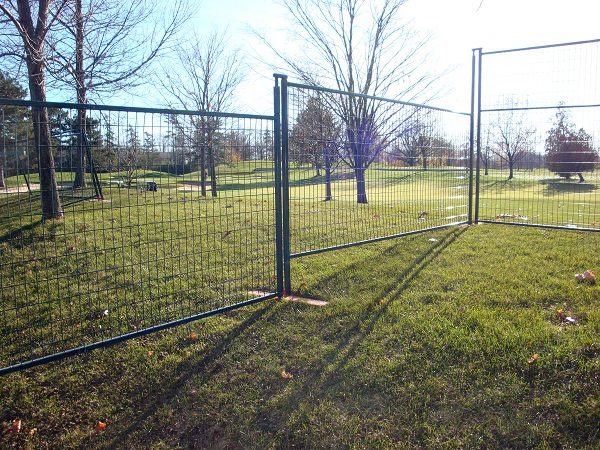
Sometimes we deal with installing temporary fence on a hill, which is even more challenging. We try to avoid these situations by moving the fence line to go around the hill. However, sometimes this isn’t possible due to the customer’s requirements. If we can’t avoid installing fence on a hill, we do several things to improve the stability of the fence line.
First, we zigzag the line if possible. A zigzagged fence line is more stable than a perfectly straight one, and helps to counteract any imbalance caused by changes in elevation. If we can, we may even use v-bracing to further improve the integrity of the fence line.
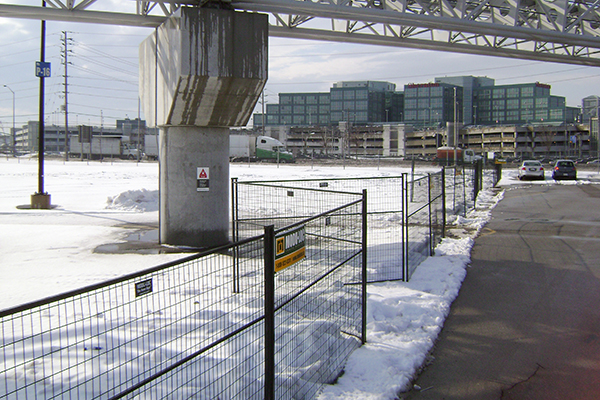
Occasionally, the topography of a site calls for additional measures. We may use spikes or t-bars to anchor the fence to the ground if there are any concerns about the fence falling over. Though this can add to the installation time, it’s important to address any stability issues to mitigate risk.
High winds
Wind is always a concern when dealing with temporary structures, and there are some sites that are simply more prone to high winds. For instance, temporary fence installed at airports or in large open fields is especially susceptible to being blown over. Add in any signage or screening, and the risk of falling fence increases exponentially.
If there are any concerns about wind, we will proactively enhance the stability of the fence. We can accomplish that using v-bracing, spikes, or t-bars. For more information about these options, check out our blog post on finding the right stability solution.
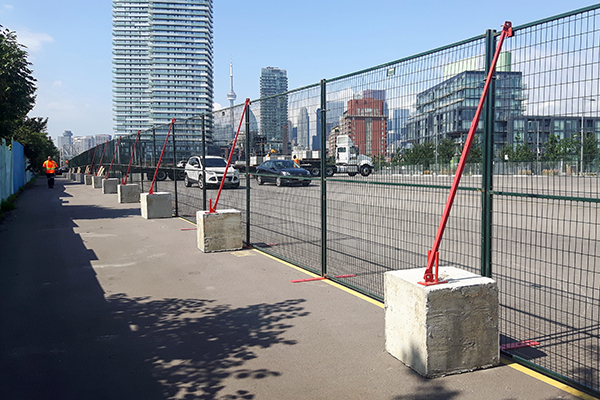
Our strongest stability solution is the concrete block ballast system, which consists of concrete blocks attached to the fence panels with wind braces. This system is best for open and uncluttered sites, as it requires room for a forklift to maneuver the blocks into place. In tight spaces, spikes and t-bars are your best bet.
Tight spaces
Speaking of tight spaces, we are sometimes called upon to set up temporary fence with as small a footprint as possible. This is often the case when we are asked to install fence indoors. Rental fence can be used for various indoor applications, including creating storage compounds in parking garages or protecting shoppers from an area that’s under renovation.
Some temporary fence components require a large footprint or clearance, which requires us to make some adjustments to the fence system if space is tight. For instance, if we need to install a gate in tight quarters, we will recommend using a sliding gate as opposed to a swing gate or hinged gate. A sliding gate doesn’t increase the footprint of the fence line, and is the best option if we don’t have enough clearance for a swing gate.

When it comes to the Modu-Loc fence system, our bases also increase the footprint of the fence line. Our bases are longer than those of our competitors, and were designed this way to ensure the stability of the fence. However, there may not always be enough room to accommodate our bases – especially indoors. In this situation, we may use hilti bases instead. Small and square, our hilti bases eat up significantly less floor space than our regular fence bases. Hilti bases do need to be anchored to the floor or ground as a safety measure, so they’re best suited for long-term projects. They are also used to permanently install our temporary fence.
Debris
Dust and debris are very common (and annoying) issues on construction sites. If not controlled, the dust generated by your work site could lead to complaints from the public and possibly even fines. Thankfully, we Modu-Loc offers several options to address this problem.

The most economical solution is our debris netting. Though it is not well-suited to controlling fine dust particles, it can prevent small debris from migrating off your site. A more heavy duty option is our privacy screen. With a tighter knit and higher opacity, it will help contain dust and also maintain privacy on site.
If aesthetics are also important, then our custom branded screen is a good option. It perfectly marries form and function by allowing you to brand your site while still controlling dust and debris.
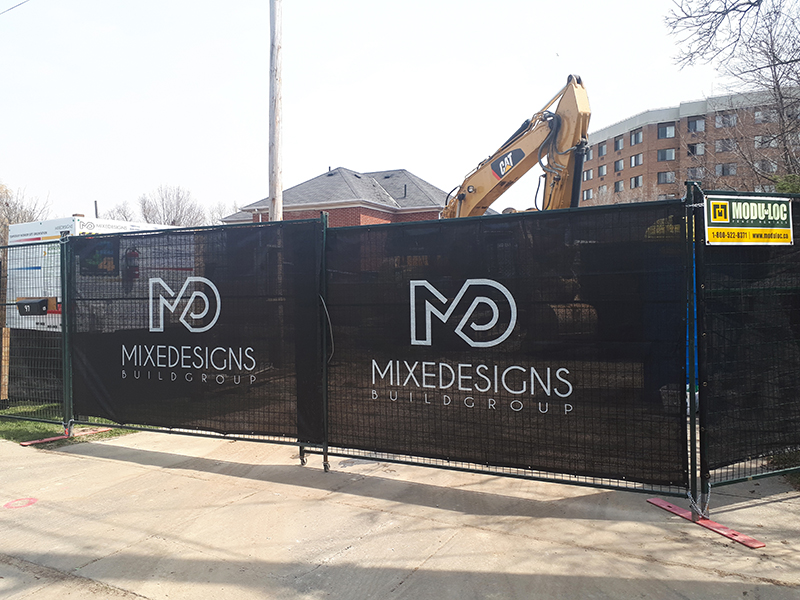
Regardless of which screening option you choose, you will need to understand the risks involved in hanging anything on temporary fence. To learn more, read our blog post about this subject, Screening on Fence: A Risky Business. There are many stability solutions available to help stabilize your fence when adding screening or banners.
High Traffic
Many of the sites we deal with are positioned in areas of high traffic – whether vehicular or pedestrian. If you have temporary fence going up around a parking lot or along a sidewalk, there are certain safety implications you need to consider.
First of all, fence can be difficult to see in the dark – making it a hazard to drivers trying to navigate a parking lot at night. We strongly recommend using delineators to improve visibility of the fence at night. Delineators are high-visibility orange with reflective strips, and can help alert drivers to potential hazards.
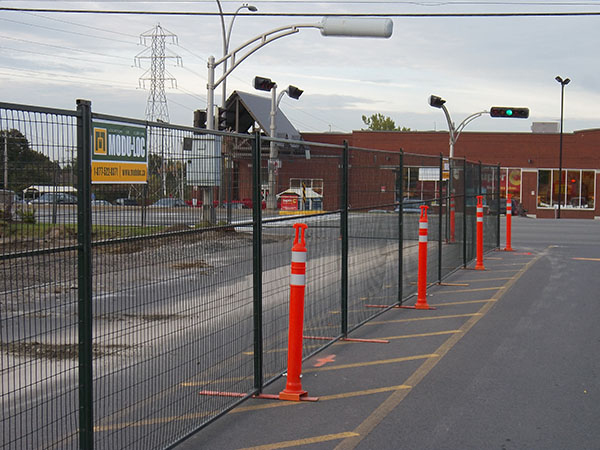
Pedestrian traffic is another consideration, especially when the fence line runs along a sidewalk or pathway. Although our bases are painted a high-visibility orange, they can still pose a trip hazard to passersby. To help mitigate the risk of a trip and fall, we can install safety ramps to cover the bases. They provide a smooth transition for pedestrians and wheeled equipment, reducing trip hazards.
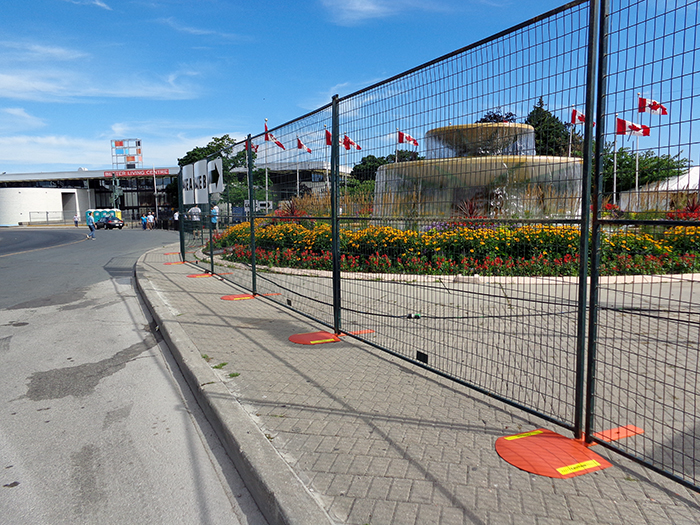
Bases can be extra dangerous in the winter, when a thick layer of snow can hide them completely. Wet snow can also make the bases slippery, so unsuspecting passersby may be caught off guard when their foot suddenly loses traction under the snow.
A great solution to this problem is delineators. Safety ramps have a low profile, and are also at risk of being buried under the snow. But delineators have a distinct advantage in that they are tall and therefore highly visible. They can alert pedestrians to the presence of a trip hazard (in this case, the base) even under a foot of snow.
These are just some of the common site characteristics we can accommodate with our temporary fence solutions. There are many other challenges we have encountered during install, and more often than not we have a product or technique that can effectively address the issue. Ultimately, every site is unique – which is why we train our field employees to be prepared for just about anything.
If you’re looking for a site containment system and have a specific problem you need to address, please contact us and ask how we can help!
We’re here to answer any questions you may have.



 Canada - EN
Canada - EN Canada - FR
Canada - FR United States
United States




